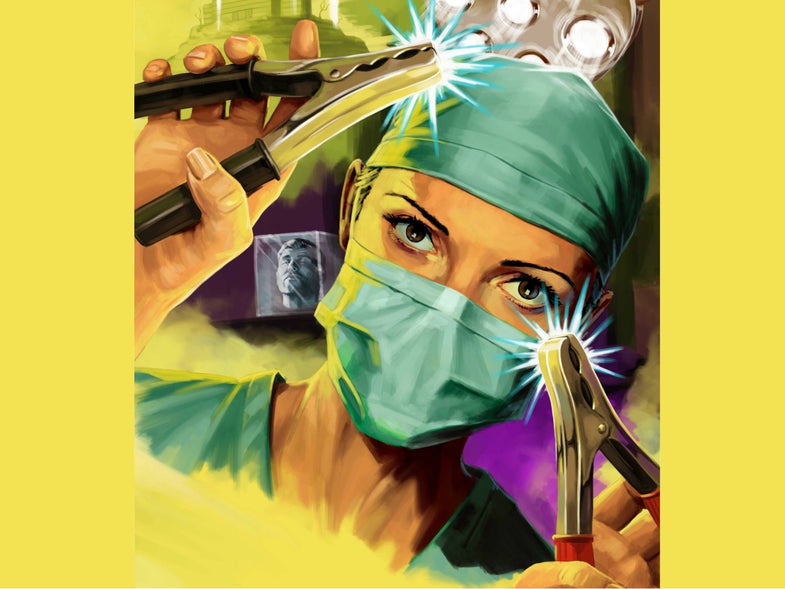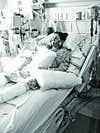How scientists are bringing people back from the dead
Pressing pause could mean the difference between life and death.


When in crisis, the human body can slow its metabolic clock to the point of appearing dead. What happens when doctors start doing it on purpose?
One afternoon in February 2011, Kelly Dwyer strapped on a pair of snowshoes and set out to hike a beaver pond trail near her home in Hooksett, New Hampshire. When the sun dropped below the horizon hours later, the 46-year-old environmental educator still hadn’t returned home. Her husband, David, was worried. Grabbing his cellphone and a flashlight, he told their two daughters he was going to look for Mom. As he made his way toward the pond, sweeping his flashlight beam across the darkening winter landscape, he called out for Kelly. That’s when he heard the moans.
Running toward them, David phoned their daughter Laura, 14, and told her to call 911. His flashlight beam soon settled on Kelly, submerged up to her neck in a hole of dark water in the ice. As David clutched her from behind to keep her head above water, Kelly slumped into unconsciousness. By the time rescue crews arrived, her body temperature was in the 60s and her pulse was almost too faint to register. Before she could reach the ambulance, Kelly’s heart stopped. The EMTs attempted CPR—a process doctors continued for three hours at a hospital in nearby Manchester. They warmed her frigid body. Nothing. Even defibrillation wouldn’t restart her heart. Kelly’s core temperature hovered in the 70s. David assumed he’d lost her for good.

But Kelly’s life wasn’t over. A doctor rushed her to nearby Catholic Medical Center, where a new team hooked her up to a cardiac bypass machine that more aggressively warmed, filtered, and oxygenated Kelly’s blood, and rapidly circulated it through her body. Finally, Kelly’s temperature crept back up. After she’d spent five hours medically dead, doctors turned off the bypass machine, and her heart spontaneously began beating again.
Incredibly, Kelly Dwyer walked out of the hospital two weeks later with only minor nerve damage to her hands. Upon seeing her, the team that rescued Kelly from the pond reacted as if they were seeing a ghost. In some ways, they were. Five years later, friends still call her “miracle woman.”
Bringing people back from the “dead” is not science fiction anymore. Typically, after just minutes without a heartbeat, brain cells start dying, and an irreversible and lethal process is set in motion. But when a person becomes severely cold before his heart quits, his metabolism slows. The body sips so little oxygen that it can remain in a suspended state for up to seven hours without permanent cell damage. Thanks to improvements in technology (like the cardiac bypass machine that saved Dwyer’s life) and medical understanding, the odds are getting better for coming back from the edge. They are so good, in fact, that some doctors and scientists are testing a bold new hypothesis: What if you could induce a near-death state in order to save lives? If it can be done, it could be a game changer for saving some of the nearly 200,000 Americans who die each year due to trauma injuries. By essentially pressing “pause,” doctors might be able to buy precious time that could mean the difference between life and death. Suspended animation is no longer the stuff of Star Wars or Avatar.

A handful of scientists and medical experts across the country is now looking for ways to suspend life in order to perform surgeries without the threat of a trauma patient bleeding to death, or to prevent tissue damage during the treatment of cardiac events. Some aim to pump ice-cold saline solution into patients’ veins. Others are searching for a suspended-animation drug. The Department of Defense too is heavily involved, with the hope that thousands of servicemen and servicewomen could benefit as well: Ninety percent of war casualties result from bleeding out on the battlefield. In 2010, it launched a $34 million initiative called Biochronicity—an interdisciplinary research project to figure out how to manipulate the human clock.
“The goal is to examine the way our bodies know that time is progressing,” explains Col. Matthew Martin, a 48-year-old active-duty trauma surgeon whose research is funded through Biochronicity. The battlefield application would be the slowing down or the stopping of time, making a wounded soldier able to survive longer—or even survive indefinitely—“so that we can get somewhere to treat the injury,” says Martin, “and then reverse that suspended state.”
***
Dr. Mark Roth’s office at the 15-acre Fred Hutchinson Cancer Research Center in Seattle is crammed with boxes of newspaper clippings and journal articles about people who came back from the “dead.” There is a skier in Norway, a toddler in Saskatchewan, and two fishermen who capsized in the Gulf of Alaska—all of whom had flatlined in the freezing cold.
“I’ve been a student of these cases for 20 years,” Roth tells me. At 59, Roth fits the mold of a mad scientist—with white hair that stands straight up, and a tendency to wave his hands while rattling on about metabolic reactions and the periodic table. He is also the winner of a MacArthur “Genius Grant” for his work manipulating the biological clocks of small fish and garden worms. He is widely recognized as a pioneer in the pursuit of using suspended animation in trauma treatment.
Hunched over a microscope, in a burgundy T-shirt with matching Converse All Stars, he invited me to take a look at a petri dish bustling with tiny, hours-old zebrafish. “Because they’re transparent, you can see their hearts beating and the blood moving about the tail,” he says. “This is the core of our own animation—the heart and blood flow. I’ll turn it off and on like a light switch. We’re going to take away the oxygen and alter their animation. We’re going to make a different kind of air.”
Using a clear tube, Roth began piping nitrogen into a transparent box containing the petri dish. “We’re going to let that sucker go all night,” he says. “The air we’re breathing is what’s in there now, but in time, this whole system will become straight-up nitrogen, which will eventually get to these creatures and turn them off. In the morning, we’ll put them back into the room air, and they’ll reanimate.”
Then Roth prepped a similar experiment—this one to show the effects, rather than the plausibility, of suspended animation. Taking two petri dishes of nematodes at precisely the same stage of development, he placed one dish in his nitrogen box and left the other on a lab bench. His hypothesis: The gassed worms’ metabolism should gradually slow until they’re essentially suspended in time, while the fresh-air siblings should keep getting bigger. Because nematodes grow quickly, his theory would be proved or disproved by tomorrow. Think of it as the worm equivalent of the movie Alien, in which the crew enters a suspended “hypersleep” state in pods in order to endure a long interstellar journey without aging. Like those pods, Roth’s nitrogen box suspends his nematode crew in metabolic stasis for the night.
Up until the early 2000s, Roth’s suspended-animation experiments were confined to the scale of tiny creatures, such as worms and fish. Then one night he was watching the science documentary series Nova on PBS. The show featured a cave in Mexico that caused spelunkers to pass out because of an invisible hydrogen-sulfide gas.
“If you breathe too much of it, you collapse,” says Roth. “It’s called ‘knock-down’—you appear dead. But if you are brought out from the cave, you can be reanimated without harm. I thought: ‘Wow! I have to get some of this!’”
After exposing mice to 80 parts per million of some of that gas at room temperature, Roth found he could induce a suspended state that could later be reversed by returning the mice to regular air, with no neurological harm—just like the spelunkers in Mexico. For Roth, it was a breakthrough. The medical community immediately took notice, seeing his work’s potential for treating heart-attack victims and cancer patients. The $500,000 MacArthur grant followed soon after.
Since then he’s been tinkering with compounds found in other deadly gases, kept under lock and key in a nearby lab room with tightly monitored security cameras and alarms. “These gases will kill you,” Roth says. “Selenide, carbon monoxide, cyanide—you could be dead in two minutes.”
But they also might save your life some day.
Roth has identified four compounds (sulfur, bromine, iodine, and selenium) that he now calls “elemental reducing agents,” or ERAs. These naturally exist in small amounts in humans and can slow a body’s oxygen use. Roth wants to develop an ERA as an injectable drug that can, for one, prevent what’s called a reperfusion injury—tissue damage that can occur after doctors halt a heart attack. This happens when normal blood flow resumes; the sudden rush of oxygen can permanently damage heart cells, leading to chronic heart failure (the leading cause of death in the world).
Roth’s current research in pigs shows that if he injects an ERA before the blockage is removed, it’s possible to keep the heart muscle from being destroyed in reperfusion.
“We’ve shown that you can intravenously inject sodium iodide into a patient, creating a 75 percent reduction in the damage that would be done to the heart during standard care,” he says. “You can preserve your heart from dying by temporarily slowing it down.” Roth recently started a private company called Faraday Pharmaceuticals, and hopes to begin experimenting with his ERAs in human heart-attack patients in early 2017.
About a five-minute walk from Roth’s lab at Fred Hutchinson, Faraday’s offices were so new when I visited in March that they smelled of fresh paint, and the whole floor was still a sea of empty cubicles. CEO Stephen Hill, a former surgeon, was tying up a few loose ends before catching a flight to North Carolina. He’d accepted the job in September 2015 after meeting Roth and talking about the potential for tapping into the natural biology that could save critically ill patients. “One of the things he said to me,” Hill recalls, “was, ‘If you took dead people and gave them state-of-the-art therapy, how many of them would recover?’”
It was a strange question, of course, because death isn’t something one “recovers” from (and neither Hill nor Roth are in the business of resurrection). But thinking of death as something malleable excited them both. “There are circumstances in which it might be necessary to alter the way the body utilizes oxygen,” Hill says, “causing damaged tissues to temporarily ‘hibernate’ rather than permanently die.”
Hill and Roth say that ERAs could one day be used for a range of medical conditions, including organ and limb transplants. Their first target, though, will likely be patients with heart attacks undergoing procedures to restore coronary-artery blood flow. Other emergency traumas, such as gunshot wounds, are promising candidates for suspended animation. And in fact, a group of medical experts on the East Coast already have the green light to do human trials on patients with such traumatic injuries, using a different time-slowing technique.
***
Dr. Sam Tisherman hates the phrase “suspended animation.” As director of the Center for Critical Care and Trauma Education at University of Maryland’s school of medicine in Baltimore, he prefers “emergency preservation and resuscitation” (EPR).
“It doesn’t have that sci-fi appeal,” he says. “But on the cute side, you might say EPR could be the new CPR. We want to preserve the person long enough to stop the bleeding and resuscitate him.”
Unlike Roth’s method, Tisherman’s approach is to cool patients into a hypothermic state, essentially inducing, intentionally, the same state that Kelly Dwyer was in. To do that, he replaces blood in the body with freezing-cold saline solution, quickly reducing the patient’s core temperature to a frigid 50 to 55 degrees Fahrenheit. It sounds extreme, but if it works, it could be a lifesaver—especially in a city that just suffered its second deadliest year for homicides (344 in 2015).
Routine care for trauma victims with injuries such as gunshot wounds typically involves inserting a breathing tube, and then using large intravenous catheters to replace lost fluids and blood while a surgeon desperately attempts to repair the damage before the patient’s heart fails. “It’s a race against time,” Tisherman says, “and these endeavors often don’t work. Only 5 to 10 percent of people in cardiac arrest from trauma survive—your chances of living are pretty slim.”
Inducing a hypothermic state could buy surgeons as much as an hour to operate. Afterward they could resume blood flow and gradually rewarm the patient. Tisherman and his colleagues have spent more than two decades perfecting their procedure in animals. They’ve had such success that in 2014, the U.S. Food and Drug Administration gave them the go-ahead for the first human trials to begin at UPMC Presbyterian Hospital in Pittsburgh, Pennsylvania. Tisherman won’t reveal whether any patients have yet been operated on, but the trial remains open. If human patients follow the success of the animal studies, their chances of survival could double.
“If we take what’s now 5 to 10 percent and make it 20 percent, that’s a big change,” Tisherman says. “That’s a game changer.”
Of course, saving patients in hospitals full of cutting-edge equipment is one thing. Saving them on the battlefield, where the nearest facilities could be hundreds of miles away, is another. That’s the challenge that plagues—and motivates—Matthew Martin, the active-duty surgeon. After four tours in Iraq and Afghanistan, Martin is trying to achieve the same results as Tisherman—without extensive equipment that would be impossible to bring to the front lines. That means using chemicals—not cold—to slow the body’s clock.

“The question,” says Martin, “is, ‘Can we decrease the person’s demand for blood so even for a period of time, he actually doesn’t need blood flowing?’ That would be the ultimate goal.”
On breaks from performing surgeries, Martin conducts research from his home base at Madigan Army Medical Center in Tacoma, Washington. There he examines the physiological effects of an experimental drug on pigs as they undergo a simulated major trauma with bleeding.
“The goal is to create ‘hip-pocket therapy,’” he says, “where a medic could carry the drug in his bag and whip out a syringe for a severely injured soldier. He could inject this drug and start the process of suspended animation, giving the soldier more time to get to a surgical facility.”
He and his colleagues have identified a series of enzymes known as PI 3-kinase, which helps regulate metabolism. They also found a drug that controls the activity of those enzymes and is already in clinical trials as a potential cancer treatment. Martin’s early data suggests that administering the drug at the moment of ischemia—when blood flow to the heart becomes inadequate—can slow down the metabolism without harming the animal.
For Martin, the sense of urgency isn’t just scientific; it’s personal. Such a drug might have saved the first patient (we’ll call him Private X) who died on Martin’s watch, in 2007, when he was the chief of trauma at a combat-support hospital in Baghdad. Arriving with a group of other soldiers and civilians who had been ravaged by an improvised explosive device, Private X’s leg was mangled. Shrapnel had penetrated his abdomen, one of his lungs was bruised, and he’d suffered multiple fractures of his ribs. After Martin and his team operated, Private X seemed stable enough for transfer.
But as soon as medics wheeled him into the ICU, everything went wrong. The soldier’s oxygen levels suddenly dropped, and internal bleeding made its way back into his bruised lung. Shortly after, he went into cardiac arrest. This time, Martin’s team couldn’t save him.

“In the U.S., with access to good hospitals, there are some high-tech options to stop the lung bleeding from the inside.” Martin says, “But they were not available. I remember just standing at the bedside feeling completely helpless.”
Meanwhile, back at Mark Roth’s lab in Seattle, he’s likewise hoping the answer to stalling time lies within a portable, injectable drug. Though ERAs might face some challenges in the FDA approval process, the eventual applications could be huge.
“When you believe you’ve found a hammer, first you have to see if you can hit a nail into the wood,” he says. “Then, if you build the utility and value, other people are going to come along later and build all sorts of things. That’s the field of dreams.”
A day after putting his nematodes to sleep, Roth returned to his lab to check on their progress. As expected, the little worms that spent the night in the nitrogen chamber hadn’t grown but were easily brought back to life when exposed to fresh air. At the same time, the ones left out on the table had grown noticeably larger. Soon they would have babies of their own.
It’s a far cry from saving a human trauma patient.
But witnessing those tiny worms “resurrected” under the white light of Roth’s microscope, it was hard not to feel some of the frenetic enthusiasm that drives him. For those worms, time had stood still—but for me, I felt I’d just seen a glimpse of the future.
Correction: The original version of this article misstated Kelly Dwyer’s age.
This article was originally published in the July/August 2016 issue of Popular Science, under the title “The Reanimators.”